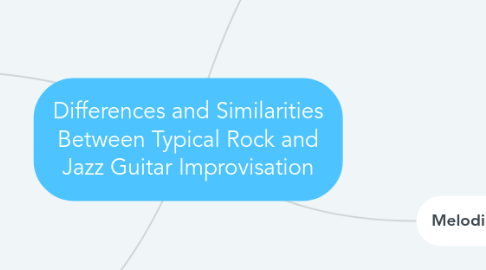
1. Rhythmic Content
1.1. Syncopation
1.1.1. More common in jazz guitar phrasing
1.2. Accents
1.2.1. In a swing contexts, jazz guitarists will often accent off eighth notes
1.2.2. Typically used sparsely in rock phrasing
1.3. Triplets
1.3.1. Used commonly in both
1.3.2. Slow triplets (e.g. quarter) less common in rock
2. Building a Solo
2.1. Tension
2.1.1. Created via dissonant notes and/or uncommon rhythmic patterns in jazz improvisation
2.1.2. Created via feedback/modulation in rock guitar
2.2. Rock typically increased in speed and pitch as it builds
2.3. Foundation from band doesn't always change much throughout rock solo
2.4. Climax
2.4.1. High note or fast repeating line in rock
3. Articulation
3.1. Bends
3.1.1. Rarely used in jazz, heavily used in rock
3.2. Slides
3.2.1. Semitone slides more prominent in jazz
3.3. Hammers/Pulloffs
3.3.1. Used as a means to play fast in rock
3.3.2. First note is often a ghost note in jazz
4. Melodic/Harmonic Content
4.1. Scales/Modes
4.1.1. Pentatonic/blues
4.1.1.1. b5 picked more often in jazz phrasing
4.1.1.2. Using pentatonic patterns for fast sections in rock
4.1.1.3. Alternative uses of pentatonic scales more prominent in jazz
4.1.1.3.1. Major pent of 2 over maj7 for lydian sound
4.1.1.3.2. Minor pent of 2 over min7 for dorian sound
4.1.2. Major modes
4.1.3. Jazz minor modes
4.1.3.1. Much less common in rock with the exception of rock fusion, which is a mix of the two genres
4.1.4. Harmonic minor modes
4.1.4.1. Used frequently in rock
4.1.4.1.1. Slash
4.1.5. Symmetrical scales/other
4.2. Linear vs Angular
4.2.1. Angular playing is less common in rock improvising
4.3. Chords
4.3.1. Rock typically diatonic
4.3.2. Jazz usually has some chords outside key centre which are targeted by improviser
4.3.3. Rock solos over power chords
4.3.3.1. Freedom of switching between minor and major (no 3 in chord)
